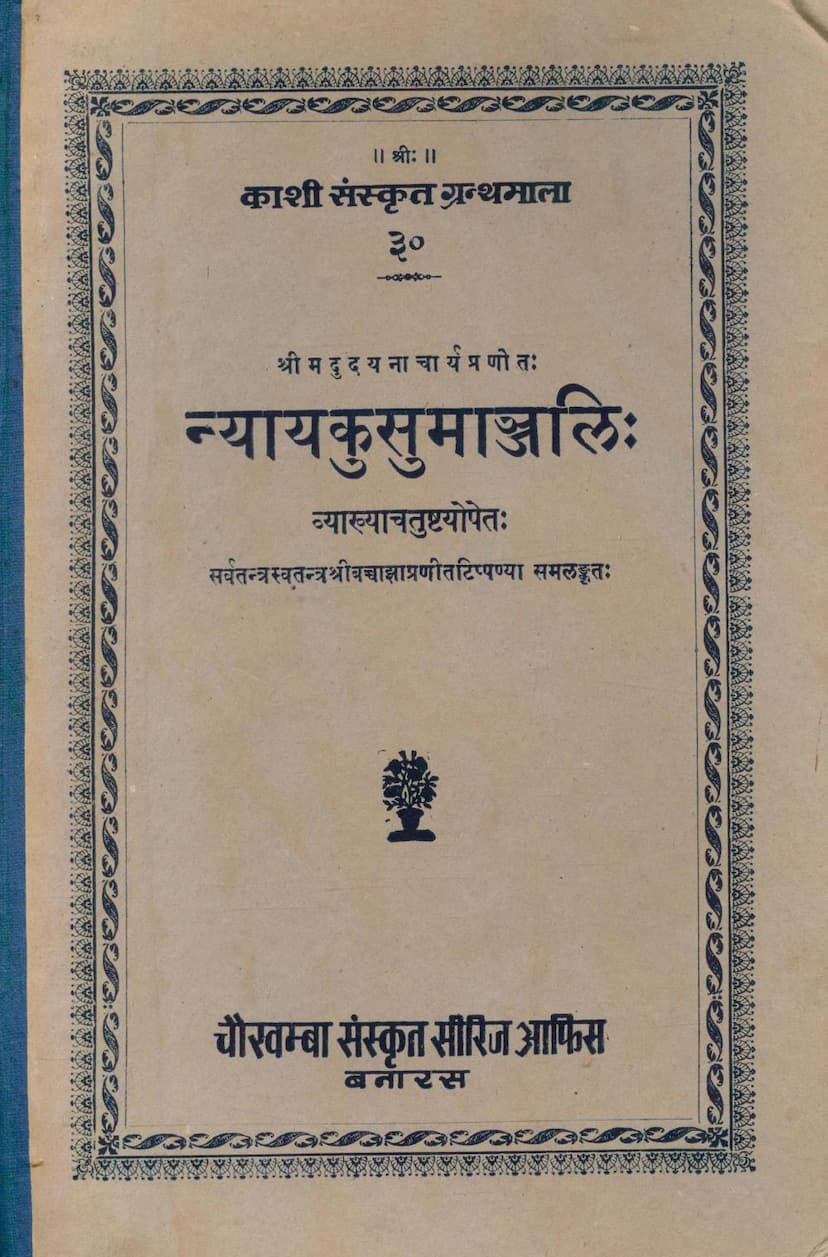Nyayakusumanjali
Added to library: September 2, 2025

Summary
Here's a comprehensive summary of the Jain text "Nyayakusumanjali," based on the provided information:
Title: Nyayakusumanjali (The Garland of Nyaya) Author: Sri Udayanacharya Commentaries: This edition includes four prominent commentaries: * Bodhihini by Varadaraja A running commentary useful for understanding Udayana's arguments line by line. * Prakasha by Mahamahopadhyaya Vardhamanopadhyaya * Prakāśikā (Jalada) by Bhagiratha alias Megha Thakkura A sub-commentary that is considered valuable. * Makarananda by Mahamahopadhyaya Ruchidatta Upadhyaya Another commentary considered valuable. Notes: The edition also features notes by Sri Dharmadatta (Bachha Jha). Editors: Nyayacharya Pt. Sri Padmaprasad Upadhyaya and Nyayacharya Pt. Sri Dhundhiraj Shastri. Foreword: Mahamahopadhyaya Dr. Gopinath Kaviraj Introduction: Panditaraja Sri Rajeshwara Shastri Dravida Publisher: Chowkhamba Sanskrit Series Office, Varanasi Publication Year: Second Edition, Vikram Samvat 2013 (1957 AD)
Core Theme and Purpose:
The Nyayakusumanjali is a seminal work in the Nyaya school of Indian philosophy. Its primary objective is to establish the existence and nature of God (Ishvara), particularly as the creator and sustainer of the universe. The author, Udayanacharya, uses logical reasoning and evidence from various philosophical schools (including critiques of atheistic and heterodox views) to build his case for theism.
Key Philosophical Arguments and Structure (as inferred from the provided text):
The text is structured into five "Stabakas" (sections or chapters), each addressing a specific argument or counter-argument. The introductory sections and the foreword/introduction highlight the following:
-
Critique of Atheistic and Heterodox Philosophies: Udayana's work systematically refutes the views of various schools that deny the existence of God or propose alternative explanations for the universe. The text mentions critiques of:
- Materialists (Charvakas): Likely denying God and the efficacy of scripture. ,Mimamsakas: While acknowledging the authority of the Vedas, they might not have accepted a personal God as the author.
- Buddhists (Saaugatas): Often characterized by their doctrine of momentariness (kshanabhanga) and anatma (non-self).
- Jainas (Digambaras): Potentially denying a creator God.
- Sankhyas: Who might attribute creation to Prakriti or Purusha in a non-theistic manner.
-
Arguments for God's Existence: Udayana presents arguments for God's existence, likely drawing from the Nyaya tradition's established lines of reasoning, which often include:
- Argument from Design/Causality (Karyatva, Prayojana): The intricate and purposeful order of the universe implies an intelligent designer.
- Argument from the Authority of Scripture (Aptoktva): The reliability of Vedic texts points to an omniscient author.
- Argument from Causality (Udayana likely connects this to the concept of Ishvara as the first mover or controller of causality).
- Argument from the Existence of Adrishta (Unseen Principle): While Mimamsakas accept Adrishta, Udayana likely connects it to God's administration.
- The text also delves into deeper philosophical discussions:
- Nature of the Self (Atman): Debates about whether the self is eternal, distinct from the body, and its relation to consciousness.
- The role of Ishvara in relation to the Self and the universe.
- The concept of Jathragni (digestive fire) as a potential symbol or manifestation of the divine in Ayurveda and Vedic thought. This is a significant point raised in the introduction, connecting scientific and scriptural understanding.
- The nature of knowledge (Jnana) and its relation to Ishvara's omniscience.
- The debate between inherent or inherent qualities (Svabhava) and acquired or causal qualities (Shakti) in explaining phenomena.
- The concept of Apurva: An unseen potency that links actions to their results, and Udayana's arguments about its nature and whether it's a product of consciousness or material elements.
- The nature of sound (Shabda): Discussions on whether sound is eternal or momentary, and its relation to consciousness and the senses.
- The refutation of momentary existence (Kshanabhanga): A key Buddhist doctrine that Udayana likely tackles.
- The refutation of the idea of causation arising from mere chance or accidental conjunctions (Akasmikata).
- The refutation of the materialist view that all phenomena, including consciousness, are merely transformations of material elements.
-
Importance of Commentaries: The extensive commentaries (Bodhihini, Prakasha, Prakashika, Makaranada) by renowned scholars underscore the profound depth and complexity of Udayana's work. These commentaries are crucial for unraveling the philosophical nuances, historical context, and the intricate logical steps of Udayana's arguments. The editors and foreword writer emphasize the scholarly effort in bringing this comprehensive edition to light.
-
Scholarly Context: The foreword by Dr. Gopinath Kaviraj highlights the historical significance of the Nyayakusumanjali and Udayanacharya's contribution to Indian thought. The text also provides biographical details about the commentaries' authors, often placing them within the rich intellectual tradition of Mithila.
Overall Significance:
The Nyayakusumanjali is a foundational text for understanding the Nyaya school's epistemological and metaphysical framework, particularly its sophisticated arguments for the existence and attributes of God. The availability of multiple commentaries in this edition makes it an invaluable resource for scholars and students of Indian philosophy seeking to engage with this complex and influential work.